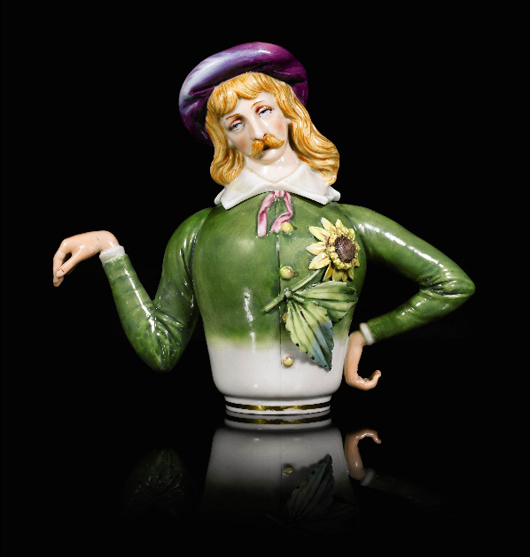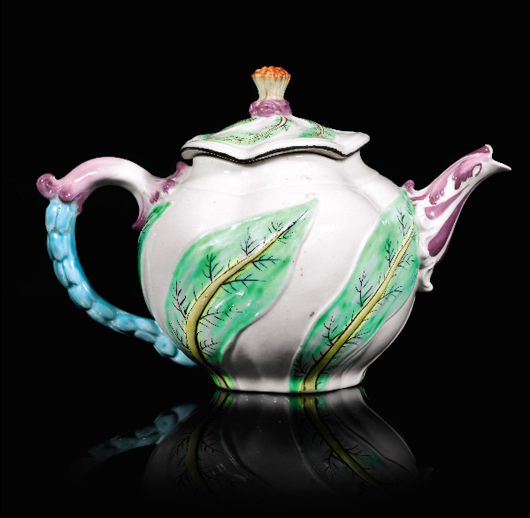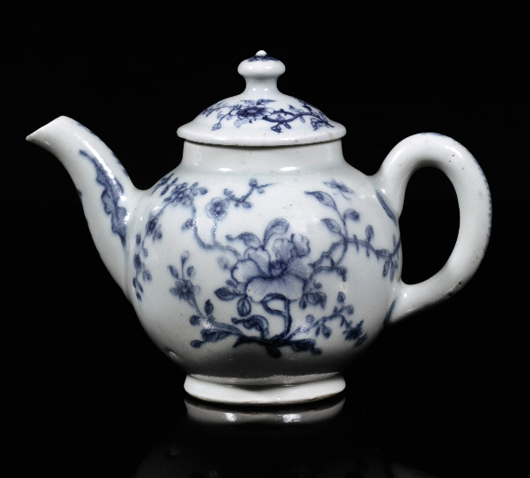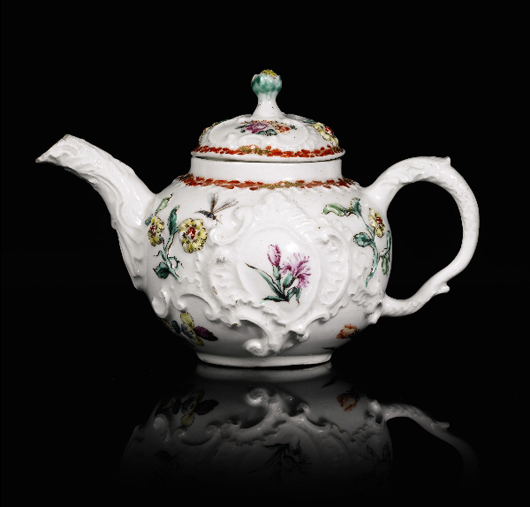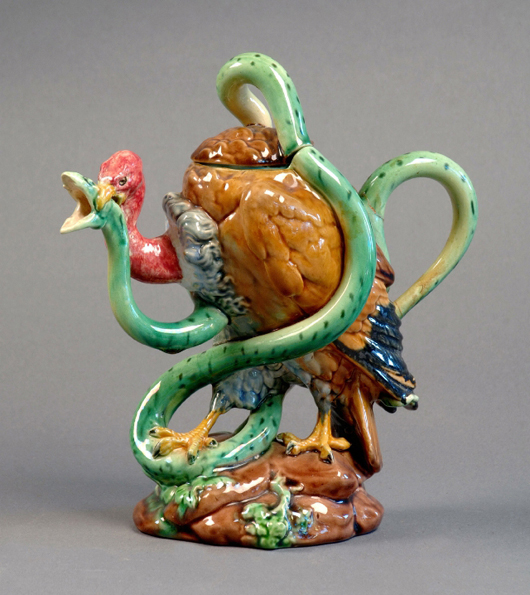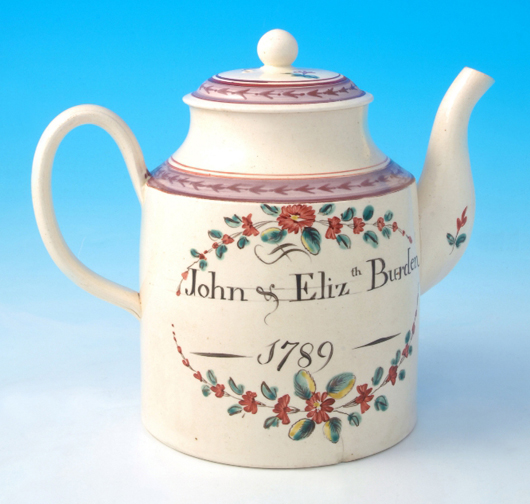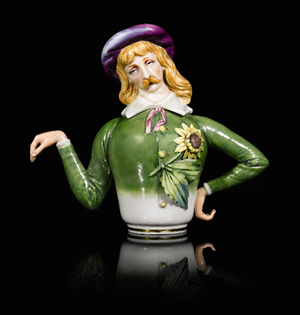
LONDON – Josiah Wedgwood had the right idea: the father of English ceramic manufacturers took home all new prototype designs of his teapots so that his wife could “road test” them for performance and suitability before they went into production. If she approved, he gave the green light and the Etruria machinery rolled.
What she would have made of the so-called ‘Aesthetic’ or ‘Patience’ teapot illustrated here is beyond imagination, but this most famous teapot is one every collector covets. The teapot is far from fit for purpose. It was difficult to fill, even harder to pour without spillage and almost impossible to keep clean, although whether it was ever intended for serious use is open to debate.
Either way, its quirky charm has ensured it a place in ceramic design history … and conservatively, a £3,000-5,000 saleroom price tag for anyone with an empty space in a cabinet of curiosities.
Designed by Richard William Binns, (1819-1900) and modeled by James Hadley, (1838-1903), it was made by Royal Worcester in 1881 as a mockery of the Aesthetic Movement. Its appearance followed the success of W. S. Gilbert and Arthur Sullivan’s operetta Patience, first performed that year at the Opera Comique in London.
An inscription on the base which reads: “Fearful consequences through the laws of Natural Selection and Evolution of living up to one’s teapot,” is a barbed commentary on how the male and female characters, modeled front and back seemingly share the same amorphous gender.
They wear the “greenery-yallery of the Grosvenor Gallery,” as the operetta puts it, puce hats and fashionable Pre-Raphaelite red hair; and aside from taking a swipe at Charles Darwin’s theories of evolution, Oscar Wilde, a champion of the Aesthetic Movement, comes in for some real stick.
While at Magdalen College, Wilde, who bears more than a passing resemblance to the figure on the teapot, wore his hair long, poured scorn on “manly” sports and decorated his rooms with peacock feathers, lilies, sunflowers, blue china and other objets d’art. Entertaining friends lavishly, he famously once remarked: “I find it harder and harder every day to live up to my blue china.”
The comment passed into literacy history, while the teapot displays all those symbols. The male figure has a sunflower as a buttonhole, while the female has a lily tucked into the waist of her outfit, but it is the limp-wristed pose adopted by the man that, perhaps, hints at a deeper symbolism.
Novelty teapots are not a modern phenomenon. In the 1750s, Staffordshire potters such as Thomas Whieldon were producing teapots shaped like pineapples and cauliflowers, while the Victorians allowed their imagination to run riot. Minton capitalized on the furor caused by Charles Darwin with a teapot in majolica modelled as a monkey.
One of the most valuable Minton teapots, however, is modeled as a vulture attacking a serpent. It was designed for Minton in 1874 by Colonel Henry Hope Crealock. The complexity of the design meant few were made and only a handful has been sold at auction in recent times. The one illustrated here had a repaired handle but still made £17,000.
Crealock was a professional soldier – he served at the siege of Sebastopol, in the Second Opium War and the Anglo-Zulu War in 1879 – and also a skilled draftsman who recorded animals and events during his military service across the world.
The accoutrements of the great British habit of tea-drinking have been collected since the new drink of tee, or tay, or tcha (the derivation of the word char) was introduced in the 17th century. Teapots must surely be the most collectible, and the search for new examples keeps literally thousands of people absorbed, many for a lifetime.
One of the rarest and most important examples to watch out for at the next flea market was made by the Chelsea factory in about 1750-52. It is molded with the leaves of the Asplenium scolopendrium, better known as the hartís-tongue fern. Only one example is known to survive today and is a copy of a French teapot of the same design, produced in the 1740s. Already sold five times at auction, having first appeared in 1941, it has a current saleroom value of £30,000-50,000.
One of the earliest teapots produced in British porcelain was made at the Limehouse factory in London. This was among the first English porcelain production centers, founded in the mid 18th century within a year of Bow and Chelsea. Production was short-lived lasting little more three or four years before it closed in early 1748.
At just 3æ (three and three quarters) inches high, the little blue and white teapot circa 1746-48, illustrated, might easily be overlooked or passed off being intended for a dolls’ tea party. Keep your eyes peeled: it’s worth £20,000-30,000, as is the rare and important Bow teapot, also illustrated, decorated with flowers by James Welsh. Only one other like it is known.
The great thing about collecting teapots is that apart from there being countless different styles and shapes to be unearthed by both well known manufacturers and anonymous ones alike, new designs appear on the market with unnerving regularity.
Once you start collecting, you might never be able to stop, particularly if you share the notion that today’s new production is tomorrow’s collectible. In 100 years’ time, it becomes an antique – officially. Given the prices some might go on to achieve, perhaps we shouldn’t poke fun at the novelty teapots sitting on the shelves at gift shops … whether they pour a good cup of char or not.
# # #

ADDITIONAL IMAGES OF NOTE
